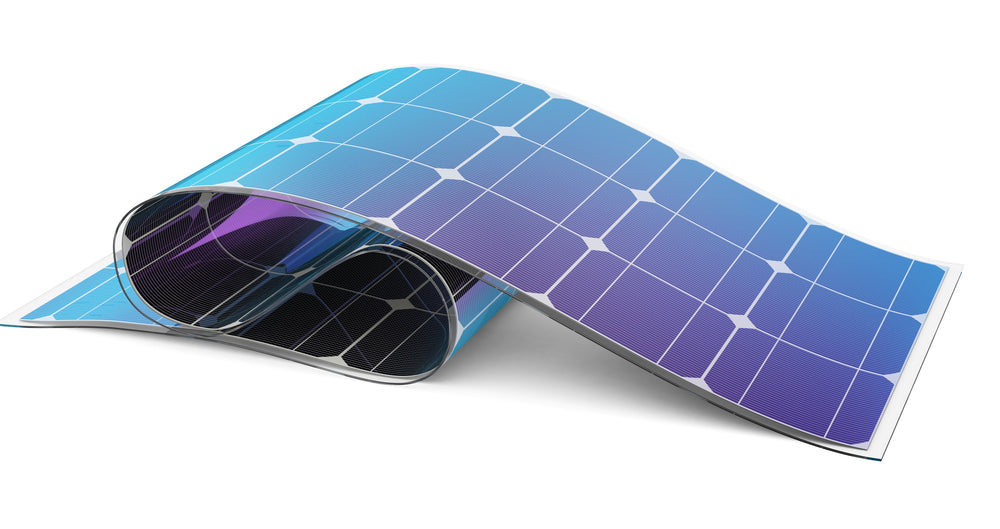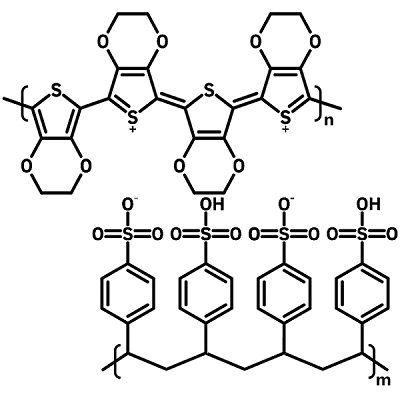PEDOT:PSS Applications
PEDOT:PSS stands out as a promising conductive polymer due to its large range of conductivities, transparency, flexibility, and ease of processing. PEDOT:PSS is known as the most widely used conductive polymer candidate for transparent electrodes, as well as hole transport layer materials in thin-film solar cells and light-emitting diodes. This is due to its:
- Low cost
- Good dispersibility in water and wide range of organic solvents
- Stability under ambient conditions
- Tuneable mechanical, electrical and optical properties
It offers significant advantage in the realm of applications for flexible and stretchable electronics including stretchable integrated circuits, active matrix displays, sensors, sensitive electronic skin, wearable electronics and etc. Soft PEDOT polymer and its composites are a good match for biological systems and are compatible for many biomedical applications.
Flexible and Transparent Conductive Films
One of the primary applications of PEDOT:PSS is in the fabrication of flexible and transparent conductive films. These films are used in flexible electronics such as flexible displays, touch panels, and wearable devices. PEDOT:PSS-based films offer excellent transparency in the visible spectrum while maintaining high conductivity. This makes them ideal for applications requiring both electrical performance and optical clarity.
Transparency
The high transparency of PEDOT:PSS is due to the molecular structure being inherently conducive to light transmission, especially in the visible range. The arrangement of the polymer chains and the presence of aromatic rings contribute to minimal light absorption. Typically in the range of 80% to 90% or even higher depending on the film thickness and processing conditions. This transparency allows light to pass through the material, making it suitable for use in transparent electrodes and optoelectronic devices.
Flexibility
The flexibility of PEDOT:PSS stems from its polymer structure. The long-chain polymer backbone allows for molecular-level flexibility, enabling the material to bend and conform to curved surfaces without cracking or losing electrical conductivity. The flexibility of these films enables their integration into bendable and stretchable electronic systems, expanding the possibilities for next-generation electronic devices.

Organic Photovoltaics (OPVs)
PEDOT:PSS plays a crucial role in organic photovoltaic (OPV) devices as a hole transport layer (HTL).
In OPVs, light-absorbing organic materials generate electron-hole pairs. Efficient charge transport is essential for converting light into electricity. PEDOT:PSS layers facilitate efficient hole extraction and transport. This leads to improved device performance such as higher power conversion efficiencies (PCEs) and stability. State-of-the-art organic solar cells (OSCs) that use PEDTO:PSS (AI 4083) as the hole transport layer achieved a record high power conversion efficiency (PCE) of 19.31%.
One of the basic operations of OPV, particularly OSCs, requires one transparent electrode for efficient light absorption. PEDOT:PSS has been among the most investigated alternative electrode materials due to its great advantage in its adjustable conductivity, transparency and flexibility.
The compatibility of PEDOT:PSS with solution processing methods such as spin coating further enhances its appeal for large-scale and low-cost OPV production.

Organic Light-Emitting Diodes (OLEDs)

In organic light-emitting diodes (OLEDs), PEDOT:PSS serves as a hole injection layer (HIL) or hole transport layer (HTL) depending on the device structure.
PEDOT:PSS films can be patterned and structured to improve device efficiency. This makes them valuable for high-performance OLED applications in displays and lighting.
PEDOT:PSS has excellent conductivity and compatibility with indium tin oxide (ITO) anode. This means that positive charges flow smoothly into the adjacent layers. As a result there is better charge distribution within the device and lower voltages are required to operate the device.
PEDOT:PSS enables efficient hole transport from the anode to the emissive layer, where recombination of electrons and holes leads to light emission.
PEDOT:PSS can be integrated into flexible OLED devices while maintaining its electrical properties. This integration enables the development of innovative display designs, such as foldable mobile phones.
PEDOT:PSS Composite Electrodes
PEDOT:PSS can be made into composite electrodes with highly conductive and stretchable materials such as:
- silver nanowires (Ag NWs)
- carbon nanotubes (CNTs)
- graphene
- graphene oxide
Incorporation of metal, metal oxide and carbon-based nanoparticles (NPs) into PEDOT:PSS has evolved into one of the most common ways to improve OLED performance. By using PEDOT:PSS as hole injection layer, external quantum efficiency (EQE) as high as 30.8% can be achieved.
Example: Nano-composite PEDOT: PSS/CNTs (110: 1, W/W) films have boosted the lifetime of OLED devices with lowered film sheet resistance and improved stability. High transmittance, excellent adhesion, and low roughness were achieved after post-treatment. OLED device based on PEDOT: PSS/CNTs composite electrode demonstrated high luminance at low minimum operating voltage.
Supercapacitors and Energy Storage
PEDOT:PSS is also used in energy storage devices such as supercapacitors. Supercapacitors based on PEDOT:PSS electrodes exhibit:
- high specific capacitance
- rapid charge/discharge rates
- excellent cycling stability
These characteristics make PEDOT:PSS-based supercapacitors suitable for applications requiring high-power delivery, such as energy harvesting systems, portable electronics, and electric vehicles.
Examples: A multi-walled carbon nanotubes (MWCNTs) reinforced cellulose and PEDOT:PSS composite electrode demonstrated excellent electrochemical properties. It had a low resistance, high specific capacitance, and good stability. Flexible PVA/PEDOT:PSS hydrogel supercapacitors exhibited excellent mechanical durability, and an excellent areal specific capacitance and good energy density.Sensors and Bioelectronics
PEDOT:PSS has biocompatible and electrochemical properties that make it a promising material for sensors and bioelectronics. It can be used as an electrode material for various sensors, including biosensors for detecting biomolecules and chemical sensors for environmental monitoring. The high conductivity of PEDOT:PSS enables sensitive and rapid detection. Its compatibility with flexible substrates expands its use in wearable and implantable sensor devices for healthcare and biomedical applications.
PEDOT: PSS as a flexible polymer material serves as a biocompatible and stable interface between the electrode surface and the cellular membrane. It causes no damage to cells in contact with it. PEDOT:PSS is also able to resist degradation in the biological environment whereas noble metal like gold cannot survive in the long term.
Examples: A fully printed temperature sensor was developed for wireless healthcare monitoring. It was made using an ink formulation of PEDOT:PSS, crosslinker and fluorinated polymer. The printed sensor showed excellent stability in environmental humidity, and high sensitivity. A sensor based on flexible hydrogel fibres of poly(vinyl alcohol) (PVA) and PEDOT:PSS demonstrated great mechanical strength and flexibility, with the ultimate tensile strength reaching up to 13.76 MPa and the elongation at break of 519.9%. The fibre sensor can also detect movement of extremely small strains as low as 0.01%, and as subtle as human movements such as knuckle bending, vocalization, pulse, and heartbeat.
Summary
PEDOT:PSS is a versatile conductive polymer widely used in electronics and energy devices. Its high conductivity, transparency, flexibility, and solution processability make it an attractive option for emerging technologies. These include flexible and wearable electronics, organic photovoltaics, OLEDs, supercapacitors, sensors, and bioelectronics. Continued research and development in materials and devices based on PEDOT:PSS are promising for advancing next-generation electronic and energy technologies. The focus is on improving performance, scalability, and sustainability.
Resources and Support
References
Fu, J. et al. (2023). 19.31% binary organic solar cell and low non-radiative recombination enabled by non-monotonic intermediate state transition, Nat. Commun., 14, DOI: 10.1038/s41467-023-37526-5.
Wu, X. et al. (2023). Exceeding 20% Efficiency for Highly Efficient and Stable Inverted Perovskite Solar Cells via Sodium Borohydride Induced Interface Engineering, Solar RRL, 7(1), DOI: 10.1002/solr.202200833

